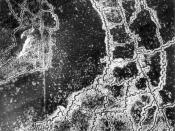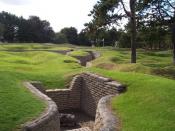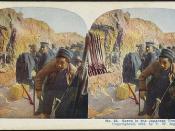The Trenches:
Dug in to house men before the decisive battle. But they were stalemated and the trenches were around for years. German trenches were up to 12 metres deep and used concrete to reinforce. British were never as good - they preferred to be offensive and didn't expect the trench warfare to last as long as it did. Trenches became complex with deferent compartments - sleeping chambers, ammunition storage... offices trenches were much better than soldiers. Trenches could stretch back kilometers. There were reserve trenches behind the front-line.
No-mans land:
The trench front-line was not straight, rather zigzagged. It was like this because it was a double line of defense against incoming attacks and did not allow out-flanking maneuvers. The area between the allied and the German front-line trenches was called no-mans land. Some places could be 10 km apart but some as little as 50 metres.
It was a nightmare for soldiers when 'going over the top' into no-mans land. Easy target for machine guns. It was muddy and with crater and was difficult to walk through. Often no-mans land was often mined.
Basics of Battle:
No such thing as a typical battle. Land, weather, time, skills of commanders. Some things in common - basic: Huge attacks concentrated on an area of the front-line. Could not be kept because of reconnaissance from aircrafts. The spot was bombarded with artillery. Once the commander though the enemy trenches had been cleared a whistle was sounded and the men went 'over the top' and moved towards the enemy. These me, in no-mans land would be fired upon with machine guns which could resist hundreds. They then had to cross barbed-wire fences and combat thee enemy in their trenches.
Mud:
Mud affected everything - what the soldier ate, drank,


